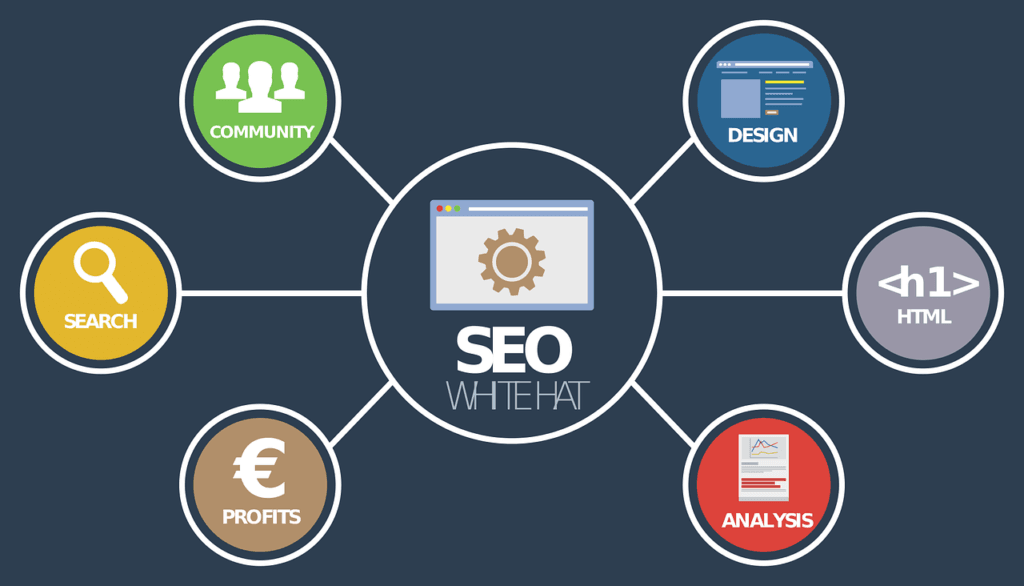This Article has been revised, edited and added to, by Poulomi Chakraborty.
- The Importance of ROI in SEO
- Setting the Stage: Defining and Calculating SEO ROI
- Essential Metrics to Track SEO ROI
- Advanced ROI Tracking: Delving Deeper into User Behavior
- ROI from Backlinks: Understanding the Value of Referrals
- ROI of Technical SEO: Measuring Site Health and Performance
- Segmentation: Analyzing ROI Across Different User Groups
- Understanding the ROI of Local SEO: Tapping into Geographical Nuances
- Future-Proofing: Staying Updated with SEO Trends and ROI Implications
- ROI-Driven SEO Audits: Periodic Assessments for Continuous Improvement
- Understanding User Intent: Aligning SEO Strategies with Conversion Potential
- Multi-Channel Convergence: Integrating SEO with Other Marketing Avenues
- Leveraging AI and Machine Learning: The Future of SEO ROI Enhancement
- Personalization and SEO: Enhancing User Experience for Higher ROI
- ROI from Mobile SEO: Tapping into the Mobile-First Era
- Continuous Improvement: Adopting an Agile Approach to SEO ROI Enhancement
- The Power of Predictive Analytics: Anticipating Future SEO ROI
- Collaborative SEO: Integrating Cross-Departmental Insights for Enhanced ROI
- Continuous Learning and SEO Training: Nurturing In-house Talent for ROI Growth
- A/B Testing and SEO: Refining Strategies for Optimal ROI
- Beyond Organic: Understanding the ROI of Universal Search Features
- Feedback Loops: Incorporating User Feedback for SEO ROI Optimization
- Conclusion
In the startup ecosystem, where every dime and second counts, understanding the return on investment (ROI) is paramount. SEO, often seen as a long-term play, is no exception. By closely monitoring SEO ROI metrics, startups can make informed decisions, adjust strategies, and drive sustainable business growth. This article will dive deep into the essential metrics and methods to track SEO ROI effectively for startups.
The Importance of ROI in SEO
ROI serves as the North Star for most business investments, guiding decision-making and strategy refinement. In the realm of SEO, understanding ROI is crucial for several reasons.
The Long Game: Understanding SEO’s Temporal Dynamics
Unlike some marketing strategies that offer immediate returns, SEO is a marathon, not a sprint.
Why SEO Takes Time:
- Search Engine Trust: New websites must earn their trust with search engines, requiring consistent effort and patience.
- Content Maturation: Freshly published content often takes time to gain traction and climb search rankings.
- Competitive Landscape: In saturated niches, overtaking established players organically can be a gradual process.
ROI as a Decision-Making Tool
Given the time-intensive nature of SEO, ensuring resources are allocated effectively is crucial.
Guided SEO Strategy Adjustments:
- Keyword Focus: If certain keywords bring higher ROI, startups might prioritize them over others.
- Content Types: Analyzing the ROI of different content formats, such as blogs, videos, or infographics, can guide content strategy.
Setting the Stage: Defining and Calculating SEO ROI
Before diving into specific metrics, understanding the fundamental concept and calculation of SEO ROI is essential.
ROI Definition in the SEO Context
In its simplest form, ROI measures the profitability of an investment.
SEO ROI Simplified:
ROI = (Net Profit from SEO Efforts – Cost of SEO Efforts) / Cost of SEO Efforts
Factors Influencing SEO Costs
To calculate ROI, startups must first ascertain the costs associated with their SEO efforts.
Key SEO Cost Components:
- In-house Team Salaries: If the startup employs an in-house SEO team, their salaries and benefits form a significant chunk of the SEO costs.
- Agency or Consultant Fees: For startups outsourcing SEO, the fees charged by agencies or consultants should be considered.
- Tool and Platform Subscriptions: Tools like Ahrefs, SEMrush, or Moz come with subscription costs, impacting overall SEO expenditure.
Essential Metrics to Track SEO ROI
While the fundamental ROI formula provides a broad overview, diving deeper into specific metrics can offer granular insights into the effectiveness of SEO efforts. These metrics not only highlight the direct returns but also provide context regarding user behavior, engagement, and overall website health.
Traffic Metrics
One of the primary objectives of SEO is driving organic traffic to the website. Understanding traffic dynamics is crucial for assessing ROI.
Key Traffic-related Metrics:
- Organic Sessions: The number of visits resulting directly from search engine results, excluding paid ads.
- New vs. Returning Visitors: This metric offers insights into user retention and the site’s ability to attract fresh audiences.
- Traffic Source Breakdown: Understanding whether traffic comes from desktop or mobile devices, direct entries, or referrals can inform SEO strategy adjustments.
Engagement Metrics
Driving traffic is only half the battle. Ensuring visitors engage with the content and navigate through the site is equally vital.
Engagement Metrics to Monitor:
- Average Session Duration: Indicates the average time users spend on the site. Higher durations often signify engaging content.
- Bounce Rate: Represents the percentage of visitors who leave after viewing only one page. A high bounce rate might signal issues with content relevance or user experience.
- Pages Per Session: Showcases the average number of pages users navigate during a single visit. Higher values can indicate effective internal linking and user interest.
Conversion Metrics
For startups, conversions—whether sales, sign-ups, or other desired actions—are the ultimate ROI indicators.
Conversion-related Metrics:
- Conversion Rate: The percentage of visitors who take the desired action, offering direct insights into ROI.
- Goal Completions: In platforms like Google Analytics, startups can define specific goals, such as form submissions or checkout completions. Monitoring these provides direct ROI data.
- Cost Per Conversion: By dividing the total SEO costs by the number of conversions, startups can understand the investment required for each successful conversion.
Advanced ROI Tracking: Delving Deeper into User Behavior

Beyond the fundamental metrics, advanced tracking methods can offer deeper insights into user behavior, preferences, and potential bottlenecks in the conversion funnel.
User Journey Mapping
Understanding the paths users take through the website can inform content strategy and user experience optimizations.
Key User Journey Considerations:
- Entry and Exit Points: Identifying which pages users most frequently enter or leave can highlight content strengths or areas needing refinement.
- Drop-off Points: In multi-step processes, such as checkout flows, pinpointing where users abandon the journey can guide UX improvements.
Heatmaps and Session Recordings
Visual tools like heatmaps and session recordings can offer direct insights into user behavior.
Benefits of Visual Behavior Insights:
- Click Patterns: Heatmaps showcase where users most frequently click, informing CTA placements or design adjustments.
- Scroll Depth: Understanding how far users scroll on pages can guide content structure and length optimizations.
- Direct User Observations: Session recordings allow startups to observe user navigations, highlighting potential UX issues or bottlenecks.

Related: Check out our free SEO suite

ROI from Backlinks: Understanding the Value of Referrals
Backlinks, often deemed the lifeblood of SEO, not only boost organic rankings but can drive referral traffic. Assessing the ROI of backlinking efforts is crucial for startups to ensure effective resource allocation.
The Power of Quality Backlinks
A robust backlink profile can significantly impact a startup’s organic visibility and authority.
Key Backlink Benefits:
- Enhanced Domain Authority: Quality backlinks from reputable sources can elevate a site’s domain authority, making it easier to rank for competitive keywords.
- Referral Traffic: Beyond SEO benefits, backlinks can directly drive users to the site, offering an additional traffic source.
- Brand Awareness: Being mentioned or linked by influential sites can boost brand awareness, indirectly impacting conversions.
Metrics to Track Backlink ROI
Understanding the effectiveness and ROI of backlink efforts requires tracking specific metrics.
Essential Backlink-related Metrics:
- Number of Referring Domains: Instead of just tracking the total backlink count, understanding how many unique domains link back is crucial.
- Referral Traffic Volume: Monitoring the traffic originating from backlinks provides direct ROI insights.
- Link Quality: Tools like Ahrefs or Moz offer domain rating or domain authority metrics, indicating the quality of backlink sources.
ROI of Technical SEO: Measuring Site Health and Performance
Technical SEO, often seen as the backbone of SEO efforts, encompasses optimizations that enhance site health and performance. For startups, understanding the ROI of these technical efforts is crucial.
The Foundations of Technical SEO
Technical SEO ensures that search engines can effectively crawl, index, and rank the website.
Core Components of Technical SEO:
- Site Speed: Ensuring the website loads quickly, offering users a seamless experience.
- Mobile Optimization: Ensuring the site is mobile-friendly, catering to the ever-growing mobile user base.
- XML Sitemaps and Robots.txt: These files guide search engine crawlers, ensuring they can effectively index the site.
Metrics to Gauge Technical SEO ROI
While the impact of technical SEO can be indirect, several metrics can offer insights into its ROI.
Key Technical SEO Metrics:
- Crawl Errors: Monitoring and addressing crawl errors ensures search engines can effectively index the site.
- Page Load Times: Tools like Google’s PageSpeed Insights can provide data on load times, impacting user experience and SEO.
- Mobile Usability: Platforms like Google Search Console offer insights into mobile usability issues, which can influence mobile rankings and user engagement.
Segmentation: Analyzing ROI Across Different User Groups

All website visitors are not the same. Segmenting ROI analysis based on different user groups can offer granular insights, guiding strategy adjustments.
The Importance of User Segmentation
Different user groups might have unique behaviors, preferences, and conversion propensities.
Why Segmentation Matters:
- Tailored Strategies: By understanding specific user group behaviors, startups can craft tailored SEO strategies.
- Optimized User Experience: Segment-based insights can guide UX optimizations, catering to specific user preferences.
Key Segmentation Metrics
Breaking down ROI metrics based on user segments can offer actionable insights.
Metrics for Segmented ROI Analysis:
- Geographical ROI: Understanding ROI based on user location can guide geo-specific SEO strategies or content.
- Device-based ROI: Segmenting metrics based on device types, such as desktop, mobile, or tablet, can inform device-specific optimizations.
- Demographic ROI: Analyzing ROI based on user demographics, like age or gender, can guide content or UX refinements tailored to specific groups.
Understanding the ROI of Local SEO: Tapping into Geographical Nuances
For startups targeting specific regions, cities, or localities, understanding the ROI of local SEO is paramount. Local SEO efforts ensure visibility among local audiences, driving targeted and often higher-converting traffic.
The Essence of Local SEO
Local SEO optimizes the startup’s digital presence to attract organic traffic from location-based searches.
Core Pillars of Local SEO:
- Google My Business (GMB): A free tool that lets businesses manage their online presence across Google, including Search and Maps.
- Local Citations: Mentions of the startup’s name, address, and phone number on other web pages, even if there’s no link.
- Local Reviews: Online reviews from local customers, impacting local search rankings and conversions.
Metrics to Gauge Local SEO ROI
Given the geo-specific nature of local SEO, several unique metrics provide insights into its effectiveness and ROI.
Key Metrics for Local SEO ROI:
- GMB Insights: Google My Business offers data on search visibility, customer actions, and other valuable metrics.
- Local Search Rankings: Monitoring rankings for geo-specific keywords can offer direct insights into local SEO effectiveness.
- Conversion Rate by Location: Analyzing how users from specific locations convert can inform local content or offer adjustments.
Future-Proofing: Staying Updated with SEO Trends and ROI Implications
The SEO landscape is in perpetual flux, influenced by algorithm updates, emerging technologies, and shifting user behaviors. For startups, staying updated with these trends and understanding their ROI implications is crucial.
Navigating Algorithm Updates
Search engines regularly tweak their algorithms, influencing organic rankings and visibility.
ROI Implications of Algorithm Updates:
- Traffic Fluctuations: Major algorithm updates can lead to significant traffic spikes or drops, directly impacting ROI.
- Strategy Adjustments: Post-update, certain SEO strategies might become more effective, while others could lose potency, influencing future ROI.
Emerging Technologies and SEO
Technological innovations can redefine SEO best practices and user search behaviors.
Technological Trends with SEO ROI Implications:
- Voice Search: The rise of voice-activated devices is reshaping search queries and behaviors, with direct ROI implications for content optimization and structure.
- Artificial Intelligence (AI): Search engines are increasingly using AI to enhance result relevance, influencing content strategies and backlinking efforts.
ROI-Driven SEO Audits: Periodic Assessments for Continuous Improvement
Regular SEO audits, centered around ROI, ensure that the startup’s SEO strategies remain aligned with objectives, market dynamics, and best practices.
The Essence of an ROI-Driven SEO Audit
Instead of just focusing on technicalities, an ROI-driven audit assesses SEO performance concerning business growth and returns.
Core Components of an ROI-Driven Audit:
- Performance Analysis: Reviewing key SEO metrics to assess performance over a specific period.
- Strategy Refinements: Based on the performance data, refining strategies to enhance future ROI.
- Future Projections: Based on current data and industry trends, projecting future ROI and adjusting strategies accordingly.
Tools and Platforms for ROI-centric SEO Audits
Several tools can streamline the audit process, offering insights into ROI and areas of improvement.
Key Audit Tools:
- Google Analytics: Offers comprehensive data on user behavior, traffic sources, conversions, and more.
- SEMrush or Ahrefs: Provide insights into backlink profiles, keyword rankings, and competitive analysis.
- Screaming Frog: A crawling tool that offers technical insights, highlighting potential technical issues impacting SEO and, in turn, ROI.
Understanding User Intent: Aligning SEO Strategies with Conversion Potential

User intent has become a cornerstone of modern SEO. By aligning content and strategies with what users genuinely seek, startups can significantly boost conversions and, consequently, ROI.
Deciphering User Intent
At its core, user intent represents the motivation behind a search query.
Categories of User Intent:
- Informational: Users seek information, such as answers to questions or more knowledge about a topic.
- Navigational: Users aim to visit a specific website or page.
- Transactional: Users intend to make a purchase or use a service.
- Commercial Investigation: Users look to compare products or services before a potential purchase.
Metrics to Gauge ROI from User Intent
By understanding and optimizing for user intent, startups can drive more targeted traffic, likely leading to higher conversions.
Key User Intent Metrics:
- CTR by Intent: Analyzing the click-through rate for keywords categorized by intent can offer insights into content relevance.
- Conversion Rate by Intent: Monitoring how effectively traffic from different intent categories converts can inform content or funnel optimizations.
- User Behavior by Intent: Observing metrics like session duration or pages per session based on user intent can guide UX or content adjustments.
Multi-Channel Convergence: Integrating SEO with Other Marketing Avenues
In today’s interconnected digital ecosystem, SEO doesn’t exist in isolation. Integrating SEO strategies with other marketing avenues can compound results, driving holistic business growth.
SEO and Content Marketing Synergy
While SEO can drive traffic, content marketing engages and converts visitors. The convergence of the two can amplify ROI.
Strategies for SEO-Content Convergence:
- Keyword-Informed Content: Crafting content around high-ROI keywords can drive targeted organic traffic.
- Content Promotion: Using SEO-optimized landing pages to promote content, such as eBooks or webinars, can enhance visibility and conversions.
SEO and Social Media: A Dynamic Duo
Social media platforms can significantly boost the reach and engagement of SEO-optimized content.
SEO-Social Strategies:
- Promoting SEO Content: Sharing blog posts, infographics, or other SEO-optimized content on social platforms can drive additional traffic.
- User Engagement Insights: Monitoring user reactions and comments on shared content can offer insights for content refinements, potentially boosting organic rankings and ROI.
Leveraging AI and Machine Learning: The Future of SEO ROI Enhancement
Emerging technologies like AI and machine learning offer innovative tools and methods to optimize SEO strategies, potentially enhancing ROI.
AI-Driven Keyword Research
Advanced AI tools can offer more nuanced keyword insights, highlighting opportunities traditional tools might miss.
AI Keyword Insights:
- Predictive Analysis: AI can predict keyword growth trends, guiding content strategies.
- Competitor Gap Analysis: AI tools can analyze competitor keyword profiles, highlighting potential keyword opportunities.
Machine Learning for User Behavior Analysis
Machine learning can provide granular insights into user behavior, predicting future actions and preferences.
Machine Learning SEO Applications:
- User Journey Predictions: Based on past behavior, machine learning can predict potential user paths, guiding internal linking or content suggestions.
- Content Performance Forecasts: Analyzing past performance data, machine learning can forecast how new content might perform, informing content creation strategies.
Personalization and SEO: Enhancing User Experience for Higher ROI
With users increasingly expecting tailored online experiences, integrating personalization with SEO strategies can significantly enhance engagement, conversions, and ROI.
Personalization in the SEO Context
At its essence, personalization involves delivering content or experiences tailored to individual users or user segments.
The SEO-Personalization Confluence:
- Tailored Content Suggestions: Using user behavior data, suggesting SEO-optimized content that aligns with individual preferences.
- Dynamic Landing Pages: Adjusting landing page content based on user search queries or past interactions, enhancing relevance and engagement.
Metrics to Gauge ROI from Personalization
Integrating personalization can have direct implications for user engagement and conversions, influencing SEO ROI.
Key Personalization-Driven Metrics:
- Engagement Rates: Monitoring metrics like session duration or pages per session can offer insights into personalization effectiveness.
- Personalization-Driven Conversions: Tracking conversions resulting directly from personalized content or landing pages.
- User Feedback: Soliciting user feedback on personalized experiences can provide qualitative insights, guiding further refinements.
ROI from Mobile SEO: Tapping into the Mobile-First Era
With mobile searches surpassing desktop and the advent of Google’s mobile-first indexing, understanding the ROI of mobile SEO is paramount for startups.
The Mobile SEO Imperative
Given the ubiquity of smartphones and changing user behaviors, ensuring a seamless mobile experience is non-negotiable.
Core Components of Mobile SEO:
- Responsive Design: Ensuring the website adjusts to varying screen sizes, offering users a consistent experience.
- Speed Optimization: Mobile users often expect faster load times, necessitating speed optimizations for mobile SEO.
- Touch-Friendly Navigation: Given the touch nature of mobile devices, ensuring touch-friendly navigation enhances user experience.
Metrics to Track Mobile SEO ROI
Given the unique nature of mobile browsing, several specific metrics can offer insights into mobile SEO ROI.
Essential Mobile SEO Metrics:
- Mobile Traffic Volume: Monitoring the volume of users accessing the site via mobile devices.
- Mobile Conversion Rates: Assessing how effectively mobile traffic converts compared to desktop can offer ROI insights.
- Mobile User Engagement: Metrics like mobile session duration or mobile bounce rate can provide insights into user experience and content relevance.
Continuous Improvement: Adopting an Agile Approach to SEO ROI Enhancement

In the fast-paced startup ecosystem, agility is often a key success determinant. Adopting an agile approach to SEO, driven by continuous learning and improvement, can ensure sustained ROI growth.
The Agile SEO Methodology
At its core, agile SEO involves continuous iterations, regular feedback loops, and rapid strategy adjustments based on data.
Key Principles of Agile SEO:
- Regular Performance Reviews: Instead of quarterly or annual SEO reviews, adopting monthly or even bi-weekly reviews to assess performance.
- Rapid Strategy Adjustments: Based on review insights, quickly adjusting strategies to enhance ROI.
- Feedback-Driven Optimizations: Incorporating feedback, be it from users, team members, or industry peers, to refine SEO strategies continuously.
Tools and Platforms for Agile SEO
Several tools can streamline the agile SEO process, offering real-time data and insights for rapid decision-making.
Key Tools for Agile SEO:
- Real-time Analytics: Platforms like Google Analytics offer real-time traffic and engagement data, allowing for on-the-fly adjustments.
- SEO Dashboards: Tools like SEMrush or Ahrefs offer dashboards with comprehensive SEO metrics, facilitating rapid performance assessments.
- Feedback Platforms: Tools like UserVoice or Hotjar can collect real-time user feedback, informing content or UX optimizations.
The Power of Predictive Analytics: Anticipating Future SEO ROI
Leveraging predictive analytics can empower startups to anticipate future SEO trends, user behaviors, and potential ROI. This forward-looking approach ensures preparedness, allowing for strategic adjustments before trends fully manifest.
Predictive Analytics in SEO: A Brief Overview
Predictive analytics involves using historical data to forecast future outcomes. In the context of SEO, it provides insights into potential traffic trends, keyword performances, and conversion propensities.
Components of SEO Predictive Analytics:
- Data Mining: Extracting and processing vast amounts of historical SEO and user behavior data.
- Statistical Analysis: Using statistical models to identify patterns and correlations within the data.
- Predictive Modelling: Leveraging identified patterns to predict future SEO performance metrics.
Metrics and Insights from Predictive Analytics
Harnessing predictive analytics can offer a plethora of insights, guiding strategic decisions and ROI optimization efforts.
Key Predictive Metrics:
- Future Traffic Estimates: Predicting potential traffic volumes based on historical data and identified trends.
- Keyword Performance Forecasts: Anticipating how specific keywords might perform in the future, guiding content and backlinking strategies.
- Conversion Predictions: Estimating future conversion rates, allowing for preemptive funnel optimizations.
Collaborative SEO: Integrating Cross-Departmental Insights for Enhanced ROI
SEO isn’t an isolated function but intersects with various other departments within a startup. Ensuring collaborative SEO efforts, where insights from diverse departments inform strategies, can significantly amplify ROI.
The Intersections of SEO with Other Functions
SEO strategies and performance can be influenced by inputs from different departments, from product development to customer support.
SEO’s Cross-Departmental Collaborations:
- Product Development: Insights into upcoming features or products can guide content strategy, ensuring timely and relevant content creation.
- Sales and Customer Support: Feedback from customers, gathered by sales or support teams, can offer content ideas or highlight potential SEO issues.
- Public Relations: PR efforts, such as press releases or media mentions, can drive referral traffic and backlink opportunities.
Metrics to Gauge Collaborative SEO ROI
Understanding the ROI of collaborative SEO involves tracking metrics that reflect the influence of cross-departmental inputs.
Collaborative SEO Metrics:
- Referral Traffic from PR Efforts: Monitoring traffic originating from media mentions or press release links.
- Content Performance: Assessing how content, crafted based on product development insights or customer feedback, performs in terms of traffic and engagement.
- Backlink Growth: Tracking the growth of backlinks resulting from PR efforts or partnerships with other departments.
Continuous Learning and SEO Training: Nurturing In-house Talent for ROI Growth
For startups, nurturing and upskilling the in-house team can yield long-term ROI benefits. Regular SEO training, informed by industry updates and best practices, ensures the team remains at the forefront of the SEO landscape.
The Imperative of Continuous SEO Learning
The dynamic nature of the SEO realm necessitates continuous learning.
Why Regular Training Matters:
- Staying Updated: Search engines and SEO best practices evolve. Regular training ensures the team remains informed.
- Skill Enhancement: Beyond updates, continuous training can elevate the team’s overall SEO skills, driving better results.
- Strategic Refinements: Training can inspire new strategies or adjustments, potentially amplifying ROI.
Metrics to Track Training ROI
Investments in training should translate to enhanced SEO performance. Several metrics can offer insights into training ROI.
Training Impact Metrics:
- Implementation Speed: Monitoring how quickly the team implements learnings from training sessions into actionable strategies.
- Performance Uplift: Assessing any uplift in key SEO metrics post-training, from traffic volumes to conversion rates.
- Innovation Indicators: Tracking any innovative strategies or tactics the team adopts post-training, and their subsequent performance.
A/B Testing and SEO: Refining Strategies for Optimal ROI
In the pursuit of higher ROI, startups can employ A/B testing within their SEO strategies. This method involves testing two or more variants to determine which performs better concerning specific metrics or goals.
The Foundations of SEO A/B Testing
A/B testing in SEO is slightly different from traditional website A/B testing, mainly because of the time it takes for search engines to index changes.
Key Considerations for SEO A/B Testing:
- Variable Identification: Determine specific SEO elements to test, such as title tags, meta descriptions, or content length.
- Controlled Environment: Ensure other variables remain constant during the testing period to avoid skewed results.
- Extended Test Duration: Due to SEO’s temporal dynamics, tests often need to run longer compared to other A/B tests.
Metrics to Assess A/B Testing ROI
Understanding the ROI of A/B tests involves assessing the performance uplift of the winning variant and the subsequent impact on business growth.
Core A/B Testing ROI Metrics:
- Traffic Uplift: Measure any increase in organic traffic resulting from the test’s winning variant.
- Conversion Rate Impact: Assess if the winning variant led to a higher conversion rate.
- Engagement Metrics: Monitor any changes in user engagement metrics, such as session duration or bounce rate, post-test.
Beyond Organic: Understanding the ROI of Universal Search Features
As search engines evolve, organic listings often share the search results page with various universal search features like featured snippets, image packs, or local map packs. Tapping into these can significantly boost visibility and ROI.
The Landscape of Universal Search
Universal search integrates multiple types of content, offering users a diverse and comprehensive search experience.
Key Universal Search Features:
- Featured Snippets: Short snippets that directly answer user queries, often driving significant traffic.
- Image and Video Packs: For queries with visual relevance, search engines display image or video packs, offering users visual content options.
- Local Map Packs: For local or location-specific queries, map packs showcase local businesses, driving localized traffic.
Metrics to Gauge Universal Search ROI
Tapping into universal search features can directly impact traffic and conversions, influencing ROI.
Universal Search ROI Metrics:
- Visibility Uplift: Monitoring any increase in search visibility resulting from feature inclusion.
- Click-Through Rate (CTR) Impact: Assessing changes in CTR after gaining a spot in features like featured snippets.
- Conversion Influence: Understanding if traffic from universal search features converts higher than standard organic traffic.
Feedback Loops: Incorporating User Feedback for SEO ROI Optimization

User feedback, whether direct comments, reviews, or surveys, can offer invaluable insights. Integrating these insights into SEO strategies can lead to enhanced user experiences, engagement, and ROI.
Harnessing User Feedback in SEO
Users often provide direct or indirect feedback on content relevance, website usability, or other factors influencing their experience.
Feedback Integration Strategies:
- Content Refinements: Adjusting content based on feedback to enhance relevance or address queries.
- UX Adjustments: Modifying website design or navigation based on user suggestions or pain points.
- Feature Requests: Implementing features or sections based on recurring user feedback or requests.
Metrics to Measure Feedback-Driven ROI
Integrating user feedback should lead to enhanced performance metrics, directly influencing ROI.
Key Feedback-Driven ROI Metrics:
- Engagement Uplift: Any increase in engagement metrics, like session duration or pages per session, post-feedback integrations.
- Feedback-Driven Conversions: Tracking conversions resulting from sections, features, or content developed based on user feedback.
- User Retention Rates: Monitoring if feedback-driven improvements lead to higher user return rates or loyalty.
Conclusion
Startups operate in a dynamic environment where agility, precision, and a keen focus on ROI are critical. In the realm of SEO, understanding the return on every investment is paramount to ensure sustainable business growth. From the basics of traffic metrics to advanced techniques like predictive analytics and A/B testing, startups have a plethora of tools and strategies at their disposal.
By aligning SEO strategies with business objectives, continuously monitoring performance, and being receptive to feedback and innovations, startups can optimize their SEO ROI. This not only ensures consistent traffic and conversions but also establishes a foundation for long-term digital success.
Incorporating the insights and methods discussed in this article will empower startups to navigate the complex SEO landscape confidently, maximizing returns and fueling business growth.
Read Next
- How to Determine the Right SEO Budget for Your Startup
- The Importance of Startup SEO Budgeting for Business Growth
- Using Google Autocomplete for Startup Keyword Insights
- Startup SEO Keyword Trends: Predictions for Future Search Behavior
- Keyword Research for Startup Email Marketing: Boosting Open Rates






















Comments are closed.